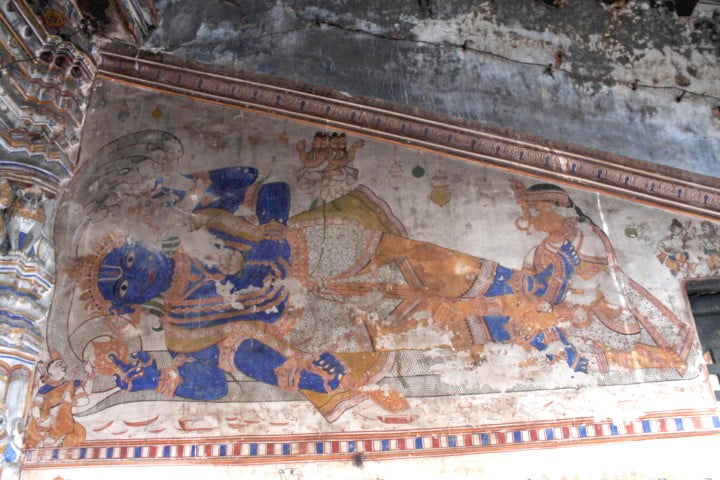Murals, Monasteries and Monks: Puri’s Legendary Mutts Stand Forlorn & Neglected

Puri: Larger-than-life murals of Lord Vishnu, Krishna and Rama with their consorts and allies, in the inner monastery of the Bada Odia Mutt welcome visitors who leave the place totally spellbound and mystified by the whole experience. The mutt in Puri boasts of the finest religious art of the region. However, these murals are on the verge of extinction.
The murals of Lord Jagannath, his elder brother Balabhadra and Devi Subhadra are the first to catch visitors’ eyes and the next are scenes from Krishna Leela and the Ramayana. “The depiction of Anantasayi Vishnu is yet another major draw among the murals of the mutt. One also finds the episode of Samudra Manthan or the Churning of the Ocean on the monastic wall,” said archaeologist Jitu Mishra, who visited the place recently.

Among the decorative figures, the ones of peacocks grab eyeballs, he added. “The ‘Kaliya Dahana’ scene of Krishna is yet another important mural of this monastery,” he said.
Having studied Puri paintings and worked on their documentation, Mishra said that Mutts or monasteries, have been playing an important role in performing seva or duty for Lord Jagannath for a long time. For example, the Gobardhana Mutt in Swargadwara found by Adi Sankaracharya in the eighth century was a popular cultural hub and a learning centre. There is a large number of mutts belonging to different sects around the Jagannath Temple. ‘Mahantas’ or heads of these monastic institutions, are also the spiritual preceptors of many followers of the sect. These mutts are treated as a social infrastructure located within historic residential neighbourhoods or ‘shahis,’ where monks or ‘bhikkus’ and devotees stay to practice meditation for spiritual growth.

The Bada Odia Mutt has the largest concentration of Puri paintings on its walls drawn in the 19th century. This mutt was established in the 15th century by Atibadi Jagannath Das, a great religious poet who composed the Odia Bhagabat. The image of Atibadi Jagannath Das is preserved in the mutt.
“Jagannath was an intimate disciple of Sri Chaitnya Mahaprabhu and founder of Atibadi Sect of Vaishnamism. The Odia Mutt makes arrangement for ‘pankti bhoga’ in the Jagamohana during ‘Rukminiharana’ festival and supplies ‘kala sari’ (black cloth) to Goddess Vimala,” said Mishra.
It is also vested with the duty of cleaning ‘Ratnavedi’ and supplying the canopy for the inner sanctuary and pillows for the Lords. The mutt provides ‘trimundi chandua’ and silk cloth for ‘chaka apasara’, til oil for ‘phooluri neeti’, oil and ghee for ‘Deva Deepavali’.

Located in Bali Sahi, Gangamata Mutt is yet another monastery where one can see traces of the 19th century murals. Tracing its origin to the Gaudiya sect, the mutt is located beside the sacred Swetaganga Tank. Similar to the ones at Bada Odia Mutt, the murals of the Hindu trinity here are huge too.
“Odisha played an important role as a link between south and north in the Indian mural tradition. However, unlike other mural traditions, such as Vijayanagara, Cholas and Nayakas of south and Orchha and Bundi of Rajput north, the Puri paintings have hardly drawn attention. One of the major concerns is their preservation from the sultry tropical weather and human interference. There is an urgent need to preserve them from further decay with the help of art restorers and experts or they might vanish forever,’’ Mishra further said.

Comments are closed.